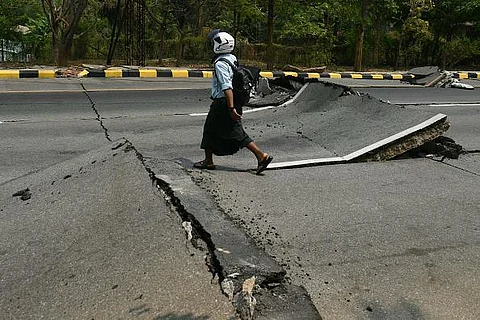
- Destinations
- Experiences
- Stay
- What's new
- Celebrating People
- Responsible Tourism
- CampaignsCampaigns
- Subscribe
- Buy Now

A severe 7.7-magnitude earthquake hit central Myanmar during midday causing tremors to be felt as far as Bangkok, Thailand. The severity of the earthquake was such that aftershocks were felt in far-flung places like Meghalaya, along with various other northeastern states, Bangladesh and China's southwest Yunnan province. People in Delhi-NCR also reported tremors following the earthquake in Myanmar. Deaths have been reported in Myanmar while the Thai capital suffered a considerable fall of its high rise infrastructure.
The city of Mandalay in Myanmar suffered significant damage, with numerous buildings falling and killing several people. The enormous earthquake also caused the famous Ava Bridge to collapse into the Irrawaddy River, among major other losses. An 'emergency' has been declared across Myanmar by the authorities and an appeal for international aid was made.
About 900 km from the epicentre, in Bangkok, the earthquakes forced a 30-story building that was being built in the Chatuchak neighbourhood to collapse. More than 40 workers are still buried beneath the debris, and at least three workers have been officially declared dead.
Residents in Bangkok described scenes of panic as buildings shook violently. Speaking to Outlook Traveller in an exclusive, Prateek Singh, an Indian youtuber based in Bangkok, expressed the people’s initial shock as they “didn’t know what to do; the loud shaking made us feel something was wrong with the building but soon things were turning into rubble and people took the fire exit.”
Singh lives in the heart of Bangkok, which is now at a standstill, and conveys that at 6, after about five hours of the calamity, people are still in shock and preparing for the night.
As buildings in Bangkok trembled fiercely, locals reported seeing scenes of panic. Because of the strength of the tremors, several people were forced to flee onto the streets, and water was observed leaking out of rooftop pools.
While the authorities are mostly trying to curb information owing to the lack of internet in the region, no real aid has reached the residents of the capital. “People are barefoot on the streets and every shop is closed. The food and sustenance present is being distributed by the people themselves,” highlighted Singh touching upon the famous Thai hospitality.
As the authorities spread the information to restrain panic on WhatsApp groups and other messaging spaces, no substantial plan of makeshift shelters or food seems to be underway. Such is the damage from the tremors in the Thai capital.
People are coming along in their cars and moving out into the outskirts of the capital where there will be fewer skyscrapers to spend the night, Singh told Outlook Traveller. Most people, Singh included, can not expect to go back to their homes for the night since half of it is rubble.
As rescue crews continue to look for survivors, the death toll is predicted to increase and the entire scope of the destruction is still being determined. The number of injured people in hospitals is overwhelming, and those impacted by the calamity urgently need food, shelter and medical aid.
In Bangkok, particularly, though any legitimate information seems inaccessible on account of the broken internet, Singh shares that no reports of death have reached him so far yet many people can be seen caught in the rubble. The death toll is estimated to be three in Bangkok and 20 in Myanmar at the time of publishing.
As the world watches in solidarity, hoping for swift relief and recovery for the affected regions, it was still something unforeseeable and unexpected for the residents of Bangkok, Singh reported. Although a general goodwill prevails within the people, the unpreparedness comes across only as shocking.
Most cities around the world continue to be obscenely unprepared for natural disasters, often perceiving climate catastrophe as a theoretical issue of the future rather than immediate. Urban infrastructure, early warning systems and emergency response mechanism seem compromised despite the recurring natural calamities that have caused suffering across the world in recent times. From the quick-fixes of polluted air quality in Delhi to the inadequate flood management systems in Jakarta, governments seem to be prioritising myopic, immediate fixes instead of long-terms ones.
